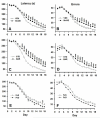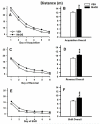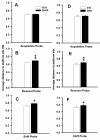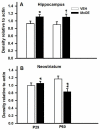Developmental manganese neurotoxicity in rats: Cognitive deficits in allocentric and egocentric learning and memory
- PMID: 27756629
- PMCID: PMC5235975
- DOI: 10.1016/j.ntt.2016.10.005
Developmental manganese neurotoxicity in rats: Cognitive deficits in allocentric and egocentric learning and memory
Abstract
Manganese (Mn) is an essential element but neurotoxic at higher exposure levels. The effects of Mn overexposure (MnOE) on hippocampal and striatal-dependent learning and memory in rats were tested in combination with iron deficiency (FeD) and developmental stress that often co-occur with MnOE. Moderate FeD affects up to 15% of U.S. children and developmental stress is common in lower socio-economic areas where MnOE occurs. Pregnant Sprague-Dawley rats and their litters were housed in cages with or without (barren cage (BAR)) standard bedding from embryonic day (E)7 to postnatal day (P)28. Dams were fed a 90% FeD or iron sufficient (FeS) diet from E15-P28. Within each litter, separate offspring were treated with 100mg/kg Mn (MnOE) or vehicle (VEH) by gavage on alternate days from P4-28. Offspring were tested as adults in the Morris and Cincinnati water mazes. FeD and developmental stress interactively impaired spatial learning in the Morris water maze. Developmental stress and MnOE impaired learning and memory in both mazes. MnOE resulted in reduced CA1 hippocampal long-term potentiation (LTP) and increased levels of α-synuclein. Preweaning MnOE resulted in cognitive deficits on multiple domains of learning and memory accompanied by impaired LTP and α-synuclein changes, effects worsened by developmental stress.
Keywords: Alpha-synuclein; Egocentric learning; Long-term potentiation; Manganese; Neurotoxicity; Spatial learning.
Copyright © 2016 Elsevier Inc. All rights reserved.
Figures








Similar articles
-
Effects of Preweaning Manganese in Combination with Adult Striatal Dopamine Lesions on Monoamines, BDNF, TrkB, and Cognitive Function in Sprague-Dawley Rats.Neurotox Res. 2019 Apr;35(3):606-620. doi: 10.1007/s12640-018-9992-1. Epub 2019 Jan 5. Neurotox Res. 2019. PMID: 30612279
-
Developmental manganese exposure in combination with developmental stress and iron deficiency: Effects on behavior and monoamines.Neurotoxicol Teratol. 2016 Jul-Aug;56:55-67. doi: 10.1016/j.ntt.2016.06.004. Epub 2016 Jun 11. Neurotoxicol Teratol. 2016. PMID: 27302314 Free PMC article.
-
Effects of developmental exposure to manganese and/or low iron diet: Changes to metal transporters, sucrose preference, elevated zero-maze, open-field, and locomotion in response to fenfluramine, amphetamine, and MK-801.Toxicol Rep. 2015;2:1046-1056. doi: 10.1016/j.toxrep.2015.07.015. Toxicol Rep. 2015. PMID: 26295019 Free PMC article.
-
Value of water mazes for assessing spatial and egocentric learning and memory in rodent basic research and regulatory studies.Neurotoxicol Teratol. 2014 Sep-Oct;45:75-90. doi: 10.1016/j.ntt.2014.07.003. Epub 2014 Aug 10. Neurotoxicol Teratol. 2014. PMID: 25116937 Review.
-
Exposure, epidemiology, and mechanism of the environmental toxicant manganese.Environ Sci Pollut Res Int. 2016 Jul;23(14):13802-10. doi: 10.1007/s11356-016-6687-0. Epub 2016 Apr 22. Environ Sci Pollut Res Int. 2016. PMID: 27102617 Review.
Cited by
-
Cognitive and behavioral effects of whole brain conventional or high dose rate (FLASH) proton irradiation in a neonatal Sprague Dawley rat model.PLoS One. 2022 Sep 16;17(9):e0274007. doi: 10.1371/journal.pone.0274007. eCollection 2022. PLoS One. 2022. PMID: 36112695 Free PMC article.
-
Intracerebral Transplantation of Neural Stem Cells Restores Manganese-Induced Cognitive Deficits in Mice.Aging Dis. 2021 Apr 1;12(2):371-385. doi: 10.14336/AD.2020.0717. eCollection 2021 Apr. Aging Dis. 2021. PMID: 33815871 Free PMC article.
-
Maintaining Translational Relevance in Animal Models of Manganese Neurotoxicity.J Nutr. 2020 Jun 1;150(6):1360-1369. doi: 10.1093/jn/nxaa066. J Nutr. 2020. PMID: 32211802 Free PMC article.
-
Developmental deltamethrin: Sex-specific hippocampal effects in Sprague Dawley rats.Curr Res Toxicol. 2022 Nov 2;3:100093. doi: 10.1016/j.crtox.2022.100093. eCollection 2022. Curr Res Toxicol. 2022. PMID: 36393872 Free PMC article.
-
Effects of Preweaning Manganese in Combination with Adult Striatal Dopamine Lesions on Monoamines, BDNF, TrkB, and Cognitive Function in Sprague-Dawley Rats.Neurotox Res. 2019 Apr;35(3):606-620. doi: 10.1007/s12640-018-9992-1. Epub 2019 Jan 5. Neurotox Res. 2019. PMID: 30612279
References
-
- Amos-Kroohs RM, Bloor CP, Qureshi MA, Vorhees CV, Williams MT. Effects of developmental exposure to manganese and/or low iron diet: Changes to metal transporters, surcrose preference, elevated zero-maze, open-field, and locomotion in response to fenfluamine, amphetamine, and MK-801. Toxicol Rep. 2015;2:1046–1056. - PMC - PubMed
-
- Baier CJ, Katunar MR, Adrover E, Pallares ME, Antonelli MC. Gestational restraint stress and the developing dopaminergic system: an overview. Neurotox Res. 2012;22:16–32. - PubMed
MeSH terms
Substances
Grants and funding
LinkOut - more resources
Full Text Sources
Other Literature Sources
Medical
Miscellaneous

